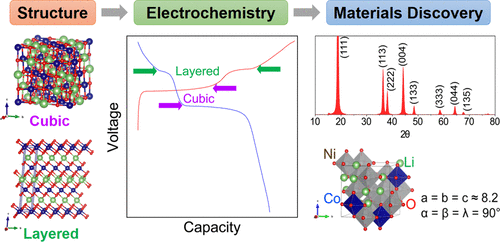当前位置:
X-MOL 学术
›
ACS Appl. Mater. Interfaces
›
论文详情
Our official English website, www.x-mol.net, welcomes your
feedback! (Note: you will need to create a separate account there.)
First-Principles Study of Lithium Cobalt Spinel Oxides: Correlating Structure and Electrochemistry
ACS Applied Materials & Interfaces ( IF 8.3 ) Pub Date : 2018-04-04 00:00:00 , DOI: 10.1021/acsami.8b00394 Soo Kim 1 , Vinay I. Hegde 1 , Zhenpeng Yao 1 , Zhi Lu 1 , Maximilian Amsler 1 , Jiangang He 1 , Shiqiang Hao 1 , Jason R. Croy 2 , Eungje Lee 2 , Michael M. Thackeray 2 , Chris Wolverton 1
ACS Applied Materials & Interfaces ( IF 8.3 ) Pub Date : 2018-04-04 00:00:00 , DOI: 10.1021/acsami.8b00394 Soo Kim 1 , Vinay I. Hegde 1 , Zhenpeng Yao 1 , Zhi Lu 1 , Maximilian Amsler 1 , Jiangang He 1 , Shiqiang Hao 1 , Jason R. Croy 2 , Eungje Lee 2 , Michael M. Thackeray 2 , Chris Wolverton 1
Affiliation

|
Embedding a lithiated cobalt oxide spinel (Li2Co2O4, or LiCoO2) component or a nickel-substituted LiCo1–xNixO2 analogue in structurally integrated cathodes such as xLi2MnO3·(1–x)LiM′O2 (M′ = Ni/Co/Mn) has been recently proposed as an approach to advance the performance of lithium-ion batteries. Here, we first revisit the phase stability and electrochemical performance of LiCoO2 synthesized at different temperatures using density functional theory calculations. Consistent with previous studies, we find that the occurrence of low- and high-temperature structures (i.e., cubic lithiated spinel LT-LiCoO2; or Li2Co2O4 (Fd3̅m) vs trigonal-layered HT-LiCoO2 (R3̅m), respectively) can be explained by a small difference in the free energy between these two compounds. Additionally, the observed voltage profile of a Li/LiCoO2 cell for both cubic and trigonal phases of LiCoO2, as well as the migration barrier for lithium diffusion from an octahedral (Oh) site to a tetrahedral site (Td) in Fd3̅m LT-Li1–xCoO2, has been calculated to help understand the complex electrochemical charge/discharge processes. A search of LiCoxM1–xO2 lithiated spinel (M = Ni or Mn) structures and compositions is conducted to extend the exploration of the chemical space of Li–Co–Mn–Ni–O electrode materials. We predict a new lithiated spinel material, LiNi0.8125Co0.1875O2 (Fd3̅m), with a composition close to that of commercial, layered LiNi0.8Co0.15Al0.05O2, which may have the potential for exploitation in structurally integrated, layered spinel cathodes for next-generation lithium-ion batteries.
中文翻译:

锂钴尖晶石氧化物的第一性原理研究:相关结构与电化学
将锂化的氧化钴尖晶石(Li 2 Co 2 O 4或LiCoO 2)组件或镍取代的LiCo 1– x Ni x O 2类似物嵌入结构整合的阴极中,例如x Li 2 MnO 3 ·(1– x)最近提出了LiM′O 2(M′= Ni / Co / Mn)作为提高锂离子电池性能的方法。在这里,我们首先回顾一下LiCoO 2的相稳定性和电化学性能使用密度泛函理论计算在不同温度下合成。与先前的研究相一致,我们发现,低和高温度的结构(即,立方尖晶石锂化LT-的LiCoO的发生2 ;或Li 2共2 ö 4(的Fd 3米)与三角层状HT-的LiCoO 2(R 3 m)分别可以用这两种化合物之间的自由能的微小差异来解释。此外,锂/的LiCoO的观测到的电压曲线2为的LiCoO的立方和三角相两种细胞2,以及迁移屏障锂扩散从八面体(O ħ)站点到四面体位置(T d中)的Fd 3米LT-栗1- X的CoO 2,经过计算以帮助理解复杂的电化学充电/放电过程。对LiCo x M 1– x O 2锂尖晶石(M = Ni或Mn)的结构和组成进行了搜索,以扩展对Li–Co–Mn–Ni–O电极材料化学空间的探索。我们预测新型锂化尖晶石材料LiNi 0.8125 Co 0.1875 O 2(Fd3米),与组合物接近的商业,分层的LiNi 0.8钴0.15的Al 0.05 Ò 2,其可具有用于开采结构上集成的,层状尖晶石阴极用于下一代的锂离子电池的电势。
更新日期:2018-04-04
中文翻译:

锂钴尖晶石氧化物的第一性原理研究:相关结构与电化学
将锂化的氧化钴尖晶石(Li 2 Co 2 O 4或LiCoO 2)组件或镍取代的LiCo 1– x Ni x O 2类似物嵌入结构整合的阴极中,例如x Li 2 MnO 3 ·(1– x)最近提出了LiM′O 2(M′= Ni / Co / Mn)作为提高锂离子电池性能的方法。在这里,我们首先回顾一下LiCoO 2的相稳定性和电化学性能使用密度泛函理论计算在不同温度下合成。与先前的研究相一致,我们发现,低和高温度的结构(即,立方尖晶石锂化LT-的LiCoO的发生2 ;或Li 2共2 ö 4(的Fd 3米)与三角层状HT-的LiCoO 2(R 3 m)分别可以用这两种化合物之间的自由能的微小差异来解释。此外,锂/的LiCoO的观测到的电压曲线2为的LiCoO的立方和三角相两种细胞2,以及迁移屏障锂扩散从八面体(O ħ)站点到四面体位置(T d中)的Fd 3米LT-栗1- X的CoO 2,经过计算以帮助理解复杂的电化学充电/放电过程。对LiCo x M 1– x O 2锂尖晶石(M = Ni或Mn)的结构和组成进行了搜索,以扩展对Li–Co–Mn–Ni–O电极材料化学空间的探索。我们预测新型锂化尖晶石材料LiNi 0.8125 Co 0.1875 O 2(Fd3米),与组合物接近的商业,分层的LiNi 0.8钴0.15的Al 0.05 Ò 2,其可具有用于开采结构上集成的,层状尖晶石阴极用于下一代的锂离子电池的电势。





















































 京公网安备 11010802027423号
京公网安备 11010802027423号